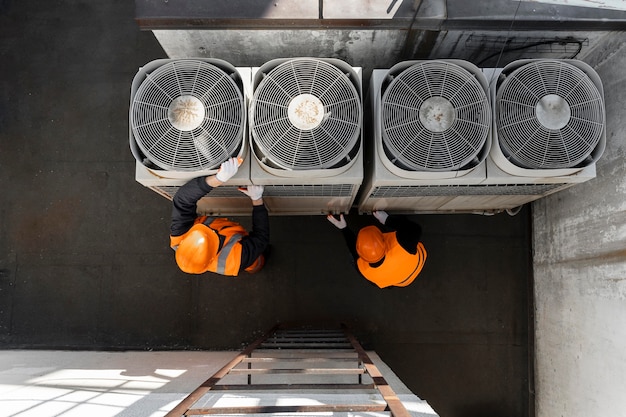When you own a business in Peoria, AZ, having an efficient heating and cooling system is essential for keeping your employees comfortable and your customers happy. Whether you’re opening a new office, or retail space, or expanding your business, installing a commercial HVAC (Heating, Ventilation, and Air Conditioning) system is one of the most critical steps in creating a comfortable indoor environment.
In this guide, we’ll cover everything you need to know about commercial HVAC installation, from the different types of systems available to the installation process itself. We’ll also touch on some tips for maintaining your system and making sure it runs efficiently year-round.
If you’re a business owner looking for heating and cooling solutions in Peoria, AZ, this guide is for you.
1. Understanding Commercial HVAC Systems
Before diving into the installation process, it’s important to understand what a commercial HVAC system is and how it works. Essentially, an HVAC system regulates the temperature, air quality, and ventilation inside your building, ensuring the space stays cool in the summer and warm in the winter. In addition to maintaining comfort, an efficient HVAC system also helps control energy costs and improve indoor air quality.
Commercial HVAC systems differ from residential ones in both size and complexity. They’re designed to handle larger spaces and more varied demands. This means you’ll need to choose the right type of system based on the size of your building, the number of employees or customers using the space, and the specific needs of your business.
2. Types of Commercial HVAC Systems
There are several types of commercial HVAC systems available, each with its own advantages and drawbacks. Here are some of the most common options for businesses:
- Split System: A split system is one of the most common types of commercial HVAC systems. It includes both an outdoor unit (which houses the compressor and condenser) and an indoor unit (which contains the evaporator). These systems are often more affordable to install, but they work best for smaller commercial spaces.
- Packaged System: In a packaged system, all the components of the HVAC system are contained in a single unit, typically located on the roof or outside the building. This type of system is ideal for larger commercial spaces and allows for easy maintenance since everything is in one place.
- VRF System (Variable Refrigerant Flow): VRF systems are highly efficient and offer excellent flexibility. They allow for different parts of the building to be heated or cooled at different temperatures, which is ideal for businesses with varying comfort needs, like office buildings or hotels.
- Rooftop Unit (RTU): A rooftop unit is exactly what it sounds like—an HVAC system that sits on the roof of your building. RTUs are popular for commercial properties because they save indoor space and are relatively easy to install and maintain.
Choosing the right system for your business will depend on your building’s size, layout, and energy efficiency goals. Consulting with an HVAC professional can help you determine which option is best for your needs.
3. The HVAC Installation Process
Installing a commercial HVAC system is a complex process that requires careful planning and professional expertise. Here’s what you can expect during the installation process:
- Initial Consultation and Assessment: The first step in any HVAC installation is a consultation with an HVAC specialist. They will assess your building’s size, layout, and usage needs to determine the best system for you. This is also the time to discuss any special requirements, like energy efficiency goals or specific temperature zones.
- Choosing the Right Equipment: Based on the initial assessment, the HVAC contractor will recommend the appropriate system for your business. This includes selecting the right size of the unit to ensure it meets your heating and cooling needs without wasting energy.
- Designing the System: The HVAC contractor will design a system that fits your building’s layout. This includes planning where the ductwork, vents, and units will be located to ensure maximum efficiency and comfort.
- Installation: Once the system has been designed and the equipment has been selected, the installation process begins. This can take anywhere from a few days to a few weeks depending on the complexity of the system and the size of the building. The contractor will install the units, connect the ductwork, and ensure the system is properly configured to meet your needs.
- Testing and Adjustments: After installation, the HVAC contractor will thoroughly test the system to make sure it’s functioning properly. They’ll check the airflow, temperature, and energy efficiency to ensure everything is working as it should.
- Ongoing Maintenance: Regular maintenance is key to keeping your commercial HVAC system running efficiently. Your contractor will likely offer a maintenance plan that includes regular inspections, filter changes, and tune-ups to keep your system in top condition.
4. Tips for Maintaining Your HVAC System
Once your commercial HVAC system is installed, it’s important to keep up with regular maintenance to avoid costly repairs and ensure the system operates efficiently. Here are a few tips to help maintain your heating and cooling system:
- Change Filters Regularly: Dirty filters can reduce airflow and force your system to work harder, leading to higher energy bills and potential damage to the system. Make sure to change filters regularly, especially during peak usage seasons.
- Schedule Regular Inspections: At least twice a year, schedule a professional HVAC inspection to ensure everything is working properly. This can help catch minor issues before they turn into major problems.
- Check the Thermostat: Make sure your thermostat is working properly and set to an appropriate temperature. Installing a programmable thermostat can help manage energy usage by automatically adjusting the temperature based on the time of day.
- Clean the Outdoor Unit: If your system has an outdoor unit, make sure it’s clear of debris like leaves, grass, and dirt. A blocked unit can reduce efficiency and cause your system to overheat.
- Inspect Ductwork for Leaks: Leaky ducts can cause cool or warm air to escape, forcing your system to work harder and leading to higher energy bills. Have your ducts inspected regularly and seal any leaks to improve efficiency.
Ready to Install Your Commercial HVAC System?
Installing a commercial HVAC system is a significant investment for any business, but with the right system and proper maintenance, you can enjoy a comfortable and energy-efficient workplace for years to come.
If you’re looking for expert heating and cooling services in Peoria, AZ, our team is here to help. Whether you’re in need of a new installation or regular maintenance for your existing system, we have the experience and expertise to keep your business comfortable year-round. Contact us today to schedule a consultation and ensure your heating and cooling needs are met!








